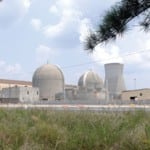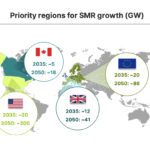If a nuclear revival is to happen, it will depend on understanding the global nature of the supply chains that support it, argues a U.S. conservative think tank.
It’s an interconnected world, says the conservative Heritage Foundation think tank in a new report, “Nuclear Energy Renaissance: Global Supply Chain Critical.” That means that global supply chains are critical to a U.S. nuclear revival.
“Any tariff or regulatory barriers to trade in nuclear components,” argues the Heritage report, “drive up the costs associated with building new reactors.” According to the report, any form of trade protectionism (such as “buy American” provisions) would make it cost-prohibitive to build new reactors.
The report is timely, because the House-passed Waxman-Markey global warming bill includes “buy American” provisions aimed at countries—specifically India and China—that do not agree to the climate regime embodied in the U.S. legislation. The bill, as passed by the House, would make it difficult for India and China to export goods to the U.S.—including forgings, castings, and other components needed for power plants—into the U.S. after 2020 if those countries do not implement acceptable (to the U.S.) CO2-reduction policies.
The White House has objected to the House trade language, although it accepts the overall legislation and has not threatened a veto. It is unlikely that the trade language will survive in a Senate version of the legislation, leading to a possible confrontation in a House-Senate conference committee, assuming the Senate passes climate legislation.
Since the costs of new reactors are already skyrocketing, says the Heritage report, written by Jack Spencer and Daniella Markheim, “protectionism could inflate the cost of new projects enough to stop the nuclear renaissance before it begins.” Some analysts believe the nuclear renaissance has already faded, despite regulatory and industry irrational exuberance, because of rising costs and the decreasing ability to finance the projects.
Others argue that rising commodities prices have already slowed U.S. nuclear development, although the prices of steel, concrete, and nuclear fuel have recently fallen. Nuclear executives say their fear is price volatility—commodities markets have been gyrating dramatically over the past couple of years.
The Heritage report claims that “the U.S. currently lacks the industrial capacity to support a substantial expansion of domestic nuclear power,” a reference to the weakening of the nuclear supply chain in the U.S. after the market for new nuclear plants evaporated in the mid-1970s. That can change as new nuclear power orders accumulate and the economy strengthens, note the analysts. If there is a burst of new nuclear plant orders, “incentives for investors to rebuild production facilities in the U.S. will rise.”
The Heritage report notes that the “U.S. did not abandon the nuclear sector altogether” during the current U.S. atomic energy drought. “Instead of building new plants, the U.S. commercial nuclear industry turned to making its existing plants run more efficiently and safer. So while other countries may lead in new plant construction, America excels in operating them,” says the report.
The Heritage report adds, “Moreover, while building commercial reactors in the U.S. stopped, building reactors altogether did not. As commercial construction waned, the nuclear components industry consolidated to meet government demand for nuclear aircraft carriers and submarines, as well as other federal requirements. These companies are now reengaging in the commercial nuclear business and will likely be at the forefront of a resurgent U.S. nuclear components industry.”
How should government policy encourage a U.S. nuclear renaissance? The Heritage Foundation offers four ideas:
- “Reject protectionist measures that restrict access to the global supply chain.” This means avoiding “buy America” and other tariff and domestic “preferences” in the development of U.S. nuclear power.
- Dismantle existing trade and investment barriers that protect foreign nuclear industries. “Much of the world’s industry is dominated by state-run—and state-subsidized—firms, and trade restrictions are used to protect those firms as a general rule,” notes the report. Those state-run companies resist market forces that can induce reforms and reduce prices.
- “Help move the Convention on Supplementary Compensation for Nuclear Damage (CSC) forward.” According to Heritage, “the CSC creates a liability framework to manage international liability issues. Parties to the convention operate under common liability rules for nuclear activities.” The U.S. has ratified the convention, but it has been unenforceable because it has not been ratified by enough other countries. Heritage asserts that “bringing the convention into force should be a top priority for the Obama Administration.
- Limit further nuclear loan guarantees. The initial idea of nuclear loan guarantees, embodied in the 2005 Energy Policy Act, says Heritage, was to jump-start a private-sector market. “Expanding the program at this point will be counterproductive,” according to the group. “It distorts capital markets, stifles competition, encourages government dependence, and suppresses private-sector financing solutions.” The U.S. government has yet to extend nuclear loan guarantees, four years after the passage of the law authorizing them.
—Kennedy Maize is executive editor of MANAGING POWER.










